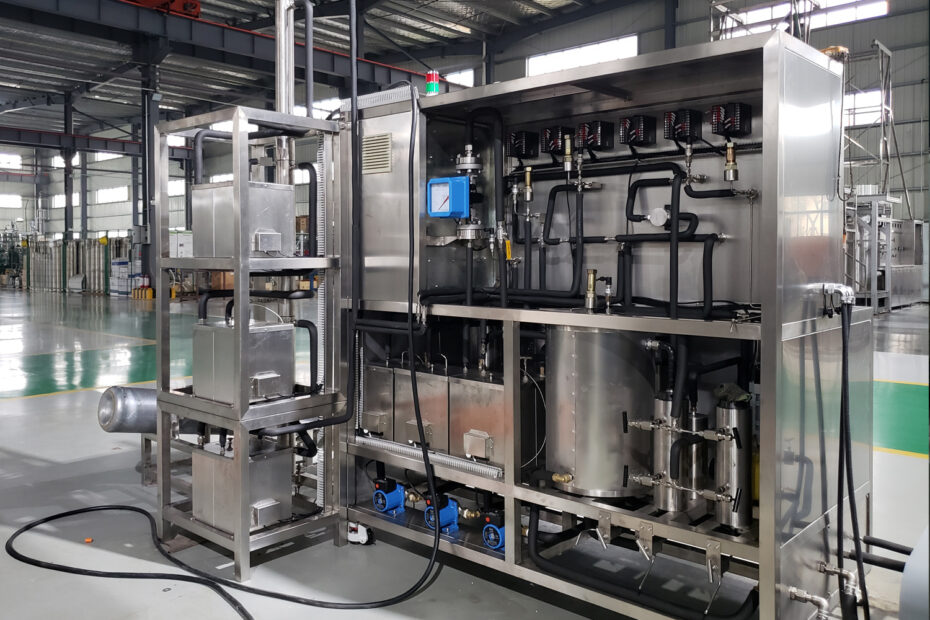Supercritical CO₂ extraction is a sophisticated technique used to extract bioactive compounds from plant materials. It involves utilizing carbon dioxide in its supercritical state, where it behaves both as a gas and a liquid, offering significant advantages over traditional solvent-based methods.
Supercritical fluid refers to a fluid between gas and liquid with a temperature and pressure above its critical temperature (Tc) and critical pressure (pc).
The process flow of supercritical CO₂ fluid extraction is set according to different extraction objects and for different extraction purposes.
Supercritical CO₂ fluid can be used to separate and extract specific substances from solid media, and can also be used for separation and purification of specific components in liquid media.
SFE is a typical operation at high solvent feed ratio, high air velocity and low fluid viscosity. Therefore, measures that can increase the solvent diffusion coefficient, reduce the diffusion distance and eliminate diffusion barriers will increase the mass transfer rate, and the full application of the basic theory of fluid dynamics will help analyze the mass transfer process of SFE.
The influence of plant chemical structure on SCF extraction
When using SCF to extract natural plants, it is necessary to use the structure and chemical knowledge of plants. The main reasons are as follows.
- In order to improve the extraction efficiency, the knowledge of plant structure can be used to determine whether the raw materials need to be pretreated first, such as grinding, slicing, reducing particle size or destroying cell walls.
- To maximize the extraction rate, concentration and yield of the target component and minimize the extraction rate, concentration and yield of the impurities, relevant natural drug chemistry knowledge needs to be used; different extraction and separation conditions can produce different extracts.
Supercritical CO₂ Extraction Process for Curcumin
Curcumin is divided into dedimethoxycurcumin, demethoxycurcumin and curcumin. The main extraction methods can be divided into organic solvent extraction and water extraction. The existing extraction methods are prone to degrading curcumin during the extraction and recovery of solvents. Supercritical carbon dioxide extraction technology, as a new green extraction and separation technology, can effectively extract high-purity curcumin from turmeric.
Preparation of Turmeric
- Drying: Ensure turmeric is thoroughly dried to reduce moisture content.
- Grinding: Mill turmeric into a fine powder to increase surface area for extraction.
Loading the Extractor
- CO₂ as a Solvent: Introduce CO₂ into the extraction vessel under controlled temperature and pressure conditions.
- Turmeric Extraction: Feed the powdered turmeric into the extractor.
Temperature and Pressure
- The experimental extraction pressure is 28Mpa, the water bath heating temperature is 45℃, and 95% ethanol is input at a constant rate of 3000mL for 1h. After 3h of input, the ethanol is dried for 1h.
Extraction Time
- Duration: Typically ranges from 2 to 4 hours to achieve optimal extraction of curcumin.
Collection and Separation
- Expansion Chamber: CO₂ depressurizes, separating into gas and liquid phases.
- Collection: Extracted curcumin is collected in a separate container.
After the turmeric raw material is crushed and sieved, it is placed in an extraction kettle for extraction. After the extraction is completed, the content of curcumin in the turmeric residue after extraction is detected, and the extraction rate of curcumin is obtained by comparing it with the content of curcumin in the raw material.
Under the condition that other conditions remain unchanged, the effect of different raw material particle sizes on the extraction effect is studied: as the raw material particle size decreases, the efficiency of supercritical carbon dioxide extraction increases. When the particle size is reduced to 0.5mm, the extraction rate no longer increases, but the material will stick together due to the small particle size, thereby increasing the difficulty and cost of crushing. Therefore, the particle size of the raw material should be selected at 1mm.
Conclusion
The yield and composition of the extracted product are mainly determined by the following three processing conditions: primary processing of raw materials, extraction conditions and separation conditions. In industrial production, each product should optimize the parameters of the above conditions.
SFE is a typical operation at high solvent feed ratio, high air velocity and low fluid viscosity. It is generally believed that SFE-CO₂ can selectively extract plant aromatic oils, esters, alcohols, aldehydes, terpenes, and light fractions in waxes and resins, while leaving heavy fractions, fatty acids, triglycerides, chlorophyll, pigments and other high molecular weight substances in waxes and resins in the extraction phase.
Compared with traditional liquid-liquid extraction, SFE-CO₂ has better selectivity, and supercritical fluid extraction technology has broad application prospects in the food, chemical, and pharmaceutical industries. With the development of industrialized SFE devices, the reliability, safety, rationality of operation, and sufficient convenience of SFE devices will be more effectively guaranteed.
